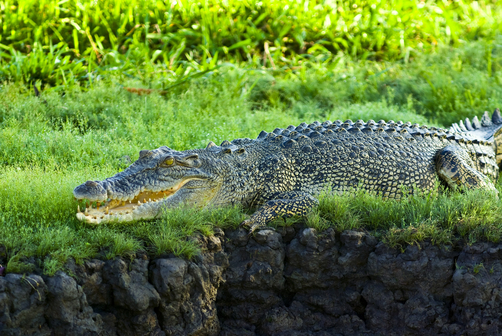It is Saltie the Saltwater Crocodile!
- Saltwater crocodiles are the world’s largest reptiles, growing an average of 3 to 5 meters (10 to 17 feet) in length, depending on the gender, and can grow up to 7 meters (23 feet) long.
- ‘Saltwater crocodiles’ are also known as ‘salties’, ‘estuarine’ and ‘Indo-Pacific crocodiles’, and their scientific name is crocodylus porosus.
- Saltwater crocodiles generally weigh between 400 to 1000 kilograms (880 to 2200 pounds) but they can be as heavy as 2000 kilograms (4400 pounds).
- Saltwater crocodiles are typically found in mangrove swamps, deltas, lagoons, rivers, and estuaries, and can also be found swimming in the ocean, which they sometimes use to travel long distances during different seasons.
- Saltwater crocodiles are native to South-east Asia, including India, and Australia.
Saltwater Crocodile
Image courtesy of National Geographic
- Saltwater crocodiles have vibration-sensing teeth, and their diet generally consists of fish, sharks, reptiles, birds, crustaceans and mammals although they cannot swallow their prey underwater.
- A saltwater crocodile’s bite is the strongest of all non-extinct animals, as its teeth are designed to hold its prey and prevent it from escaping.
- Saltwater crocodiles are the most dangerous crocodile, although attacks are not frequent, however there are usually a couple of human fatalities each year.
- Saltwater crocodiles can lay up to 60 eggs at a time and baby salties are pale yellow in colour with black patterns, while the adults are generally murky green or greenish-black in colour with a pale yellow underbelly.
- In 1971, 95% of the original Australian saltwater crocodile population had been hunted, commonly for its skin, however the species is now protected in Australia, and the population has recovered.
Bibliography:
Saltwater Crocodile, 2012, Northern Territory Tourism Central, <http://www.nttc.com.au/saltwater-crocodile>
Saltwater Crocodile, 2013, Wikipedia, <http://en.wikipedia.org/wiki/Saltwater_crocodile>







